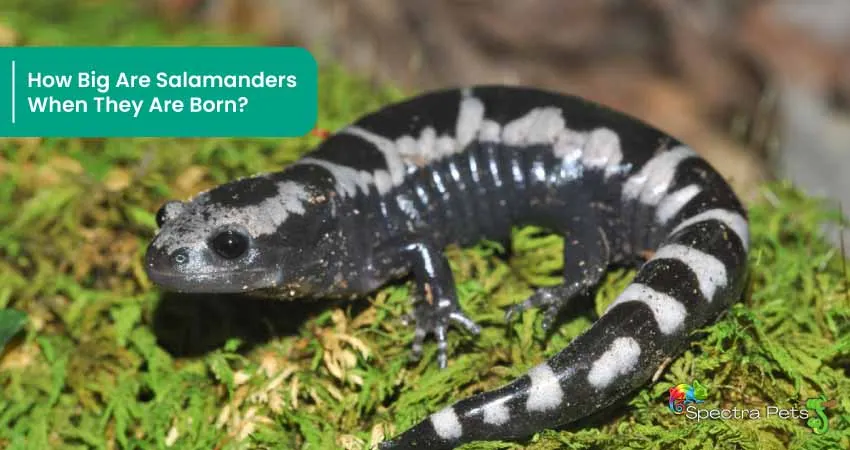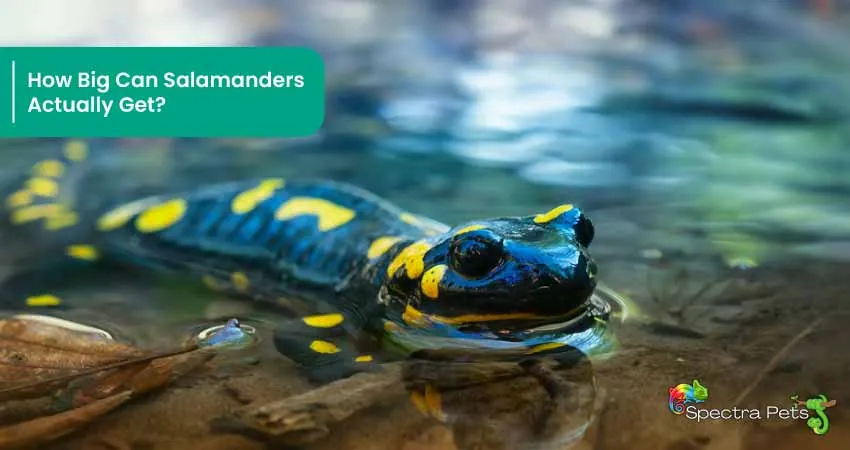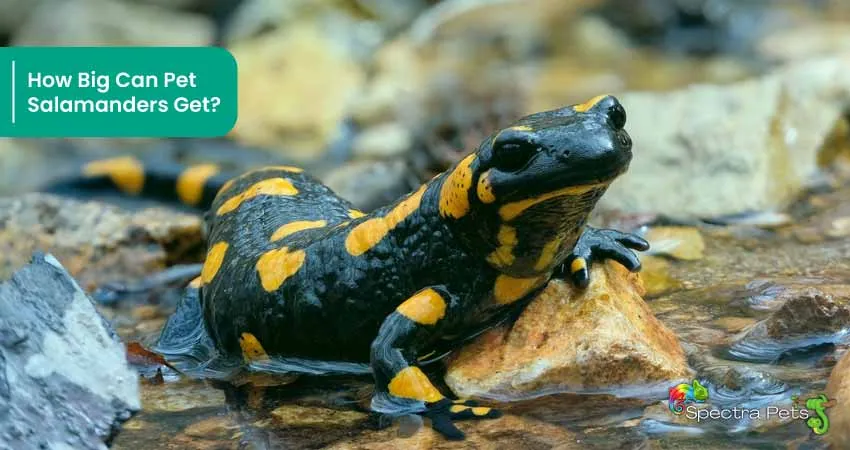Are you thinking about bringing home a salamander as your next pet? With such an incredibly wide variety of species—from dwarf to giant specimens—salamanders provide plenty of captivating choices for any pet lover.
But before focusing on the colors, shapes, and sizes that make each one attractive, it’s important to understand just how big these little amphibians can become. There are more than 650 species of amphibians classified as “salamanders” around the world and their sizes vary widely. Yes, they range from the tiny Thorius arboreus that’s just over an inch long to the Chinese giant salamander that can grow up to six feet long.
In this blog post, we’ll examine salamanders of various sizes, from tiny, small specimens all the way up to some surprisingly large varieties. Read on if you’re curious about adding a new species as part of your family’s flock.
How Big Are Salamanders When They Are Born?

The size of salamanders when they are born can vary greatly depending on the species. Some salamanders, such as the spotted salamander, are born fully formed and are only a few inches long. Others, such as the mudpuppy and the axolotl, are born in larval form and must undergo metamorphosis before reaching adult size.
In general, salamanders are born small and grow quickly, reaching their adult size within a few years. The size of an adult salamander can range from less than an inch to over five feet, depending on the species.
Okay, so salamanders are born very small. But how big do they actually get over time? I’ve laid out a lot more on this in the next section.
How Big Can Salamanders Actually Get?

Normally, most salamanders are born small and grow quickly, reaching their adult size within a few years. The size of an adult salamander can range from less than an inch to over five feet, depending on the species.
It is worth noting that the size of salamanders can also be influenced by factors such as diet and habitat. Salamanders that have access to plenty of food and live in suitable habitats are likely to grow larger than those that do not.
For now, let’s have a better look at some of the biggest salamanders in this world :
Chinese Giant Salamander
The Chinese giant salamander is the largest amphibian in the world and is native to East Asia. These salamanders can grow to be over five feet long and weigh up to 140 pounds. They are a protected species in China, and conservation efforts are underway to protect them and their habitats.
This amphibian has a distinctive appearance, with a large, robust body and wrinkled skin. It has small eyes and a wide, flat head, and its color can range from dark brown to almost black.
In the wild, Chinese giant salamanders live in fast-flowing rivers and streams, where they feed on fish, crustaceans, and other aquatic animals. They are nocturnal animals and spend most of their time hiding in caves and crevices during the day.
These salamanders are facing many challenges, including habitat destruction and pollution. They are also highly prized in the pet trade and are frequently hunted for their meat, which is considered a delicacy in some parts of East Asia.
Conservation efforts are being put in place to protect the Chinese giant salamander and ensure that it continues to thrive in the wild. This includes efforts to protect their habitats and regulate the pet trade.
South China Giant Salamander
The South China giant salamander is a species of giant salamander that is native to China. It is one of the largest amphibians in the world, reaching lengths of over five feet and weighing up to 110 pounds. This amphibian is closely related to the chinese salamander, and shares similar appetite, size, and appearance.
The South China giant salamander is a protected species in China and is listed as critically endangered by the International Union for Conservation of Nature (IUCN). This is due to a number of threats, including habitat destruction, pollution, and over-exploitation for the pet trade and its meat, which is considered a tasty treat in some parts of Asia.
Hellbender
The hellbender salamander, also known as the “snot otter” or the “devil dog,” is a species of giant salamander that is native to the eastern United States. It is one of the largest salamanders in North America, reaching lengths of up to two feet and weighing up to four pounds.
The hellbender salamander is listed as a species of concern by the United States Fish and Wildlife Service and is considered vulnerable in some states. This is due to a number of threats, including habitat destruction, pollution, and over-collection for the pet trade.
The hellbender salamander has a large, flat head and wrinkled skin. It is typically dark brown or olive in color, with dark mottling on its body.
In the wild, hellbender salamanders live in fast-flowing rivers and streams, where they feed on crayfish, insects, and other small aquatic animals. They are nocturnal animals and spend most of their time hiding under rocks and debris during the day.
Greater Siren
The greater siren salamander is a species of aquatic salamander that is native to the southeastern United States. It is one of the largest salamanders in North America, reaching lengths of up to two feet.
In terms of appearance, this salamander has a brown-to-black body with dark mottling everywhere. Their bodies are long and slender, and their skin is smooth and shiny.
Wild greater sirens live in slow-moving streams and wetlands, where they feed on insects, crustaceans, and other small aquatic animals. They are nocturnal animals and spend most of their time hiding under rocks and debris during the day.
Lesser Siren
Similar to the greater siren subspecies, the lesser siren is also a species of aquatic salamander that is native to the southeastern United States. It is a relatively large salamander, reaching up to 30 inches in length, and has two pairs of small, external gills on the sides of its head.
This subspecies is generally found in slow-moving or still bodies of water, such as swamps, marshes, and ponds. It is a carnivorous species that feeds on insects, worms, and other small aquatic animals. Like other salamanders, the lesser siren has a thin, moist skin that helps it to breathe and regulate its body temperature.
Axolotl
The axolotl, also known as the Mexican walking fish, is a species of aquatic salamander that is native to the lakes of central Mexico. It is a critically endangered species, with a declining population due to habitat loss and the introduction of non-native species into its habitat.
This is a relatively large salamander, reaching up to a foot in length, and has distinctive feathery gills on the sides of its head. Unlike most salamanders, the axolotl is permanently aquatic and does not undergo metamorphosis into an adult terrestrial form. It is a carnivorous species that feeds on small aquatic animals, such as worms and insects.
Well, these measurements apply to salamanders in the wild. But, how about the ones in captivity? Stay with me as I explain more on this down below :
How Big Can Pet Salamanders Get?

The size of a pet salamander is also dependent on its species. Some smaller species of salamander, such as the fire-bellied salamander, can reach lengths of only a few inches, while others, like the Chinese giant salamander, can grow to be several feet long.
Realistically, pet salamanders should be housed in an enclosure that is large enough to accommodate their adult size and provide them with adequate space to move around and explore. It is also important to provide them with a proper diet and a suitable habitat in order to ensure that they grow and thrive in captivity.
If you nurture your pet salamander properly, it can easily outgrow its natural growth.
Frequently Asked Questions (FAQs)
Do Giant Salamanders Exist?
Absolutely, giant salamanders exist – and they are quite impressive creatures! For example, the Chinese Giant Salamander (Andrias davidianus) is the world’s largest living amphibian and can reach up to 1.8 meters in length. They live in fast-flowing streams and lakes throughout China, traveling both underwater and on land.
How Big Is A Giant Salamander?
The Chinese giant salamander is the largest species of giant salamander, and individuals of this species can reach up to 6 feet in length and weigh up to 140 pounds. Other species of giant salamander, such as the Japanese giant salamander and the North American hellbender, are generally smaller, with lengths ranging from 2 to 4 feet.
Is Giant Salamander Rare?
Yes, giant salamanders are considered rare, with some species being critically endangered. The Chinese giant salamander, the largest species of salamander, is considered critically endangered due to habitat loss and over-exploitation. The Japanese giant salamander and the North American hellbender are also considered to be at risk due to habitat destruction and other factors.
What Is The Biggest Salamander On Record?
The Chinese giant salamander is the largest salamander on record, with individuals reaching up to 6 feet in length and weighing up to 140 pounds.
How Big Do Tiger Salamanders Get?
Tiger salamanders can reach lengths of up to 8 inches and are generally heavier and more robust than other species of salamander.
How Big Do Spotted Salamanders Get?
Spotted salamanders are named for the distinctive yellow or orange spots that cover their dark bodies. These amphibians can reach lengths of up to 8 inches.
Wrapping Up
So there you have it! Now you know everything there is to know about how big salamanders can grow. Keep these little guys in mind the next time you’re out for a walk in the woods. Also, by understanding how large they can grow, you will be able to design an appropriately-sized home for the young salamander, who will soon grow into a big guy.

